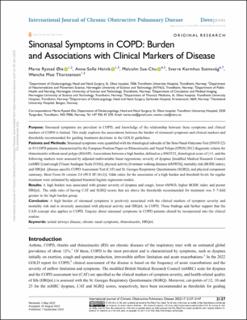| dc.contributor.author | Øie, Marte Rystad | |
| dc.contributor.author | Helvik, Anne-Sofie | |
| dc.contributor.author | Sue-Chu, Malcolm | |
| dc.contributor.author | Steinsvåg, Sverre Karmhus | |
| dc.contributor.author | Thorstensen, Wenche Moe | |
| dc.date.accessioned | 2023-03-08T14:03:29Z | |
| dc.date.available | 2023-03-08T14:03:29Z | |
| dc.date.created | 2022-09-08T09:52:29Z | |
| dc.date.issued | 2022 | |
| dc.identifier.citation | The International Journal of Chronic Obstructive Pulmonary Disease. 2022, 17, 2137-2147. | en_US |
| dc.identifier.issn | 1176-9106 | |
| dc.identifier.uri | https://hdl.handle.net/11250/3057133 | |
| dc.description.abstract | Purpose: Sinonasal symptoms are prevalent in COPD, and knowledge of the relationship between these symptoms and clinical markers of COPD is limited. This study explores the associations between the burden of sinonasal symptoms and clinical markers and thresholds recommended for guiding treatment decisions in the GOLD guidelines.
Patients and Methods: Sinonasal symptoms were quantified with the rhinological subscale of the Sino-Nasal-Outcome-Test (SNOT-22) in 93 COPD patients characterized by the European Position Paper on Rhinosinusitis and Nasal Polyps (EPOS) 2012 diagnostic criteria for rhinosinusitis without nasal polyps (RSsNP). Associations between a high burden, defined as a SNOT22_rhinological score of ≥ 11, and the following markers were assessed by adjusted multivariable linear regressions; severity of dyspnea [modified Medical Research Council (mMRC)] and cough [Visual Analogue Scale (VAS)], physical activity [6-minute walking distance (6MWD)], mortality risk (BODE index), and HRQoL [disease-specific COPD Assessment Test (CAT) and St. Georges Respiratory Questionnaire (SGRQ), and physical component summary, Short Form-36 version 2.0 (PCS SF-36v2)]. Odds ratios for the association of a high burden and threshold levels for regular treatment were estimated by adjusted binomial logistic regression models.
Results: A high burden was associated with greater severity of dyspnea and cough, lower 6MWD, higher BODE index and poorer HRQoL. The odds ratio of having CAT and SGRQ scores that are above the thresholds recommended for treatment was 5– 7-fold greater in the high burden group.
Conclusion: A high burden of sinonasal symptoms is positively associated with the clinical markers of symptom severity and mortality risk and is inversely associated with physical activity and HRQoL in COPD. These findings add further support that the UAD concept also applies to COPD. Enquiry about sinonasal symptoms in COPD patients should be incorporated into the clinical routine. | en_US |
| dc.language.iso | eng | en_US |
| dc.publisher | Dove Medical Press Ltd. | en_US |
| dc.rights | Navngivelse-Ikkekommersiell 4.0 Internasjonal | * |
| dc.rights.uri | http://creativecommons.org/licenses/by-nc/4.0/deed.no | * |
| dc.title | Sinonasal Symptoms in COPD: Burden and Associations with Clinical Markers of Disease | en_US |
| dc.title.alternative | Sinonasal Symptoms in COPD: Burden and Associations with Clinical Markers of Disease | en_US |
| dc.type | Peer reviewed | en_US |
| dc.type | Journal article | en_US |
| dc.description.version | publishedVersion | en_US |
| dc.source.pagenumber | 2137-2147 | en_US |
| dc.source.volume | 17 | en_US |
| dc.source.journal | The International Journal of Chronic Obstructive Pulmonary Disease | en_US |
| dc.identifier.doi | 10.2147/COPD.S372991 | |
| dc.identifier.cristin | 2049779 | |
| cristin.ispublished | true | |
| cristin.fulltext | original | |
| cristin.qualitycode | 1 | |

